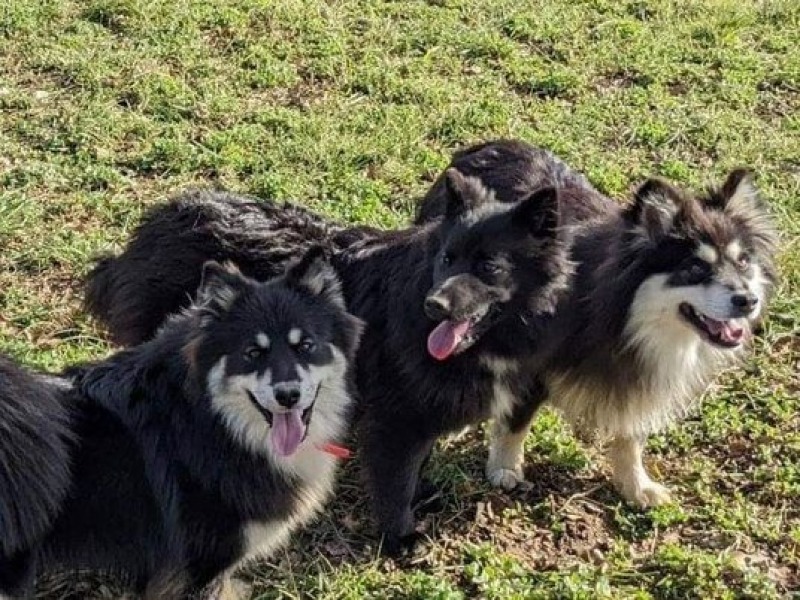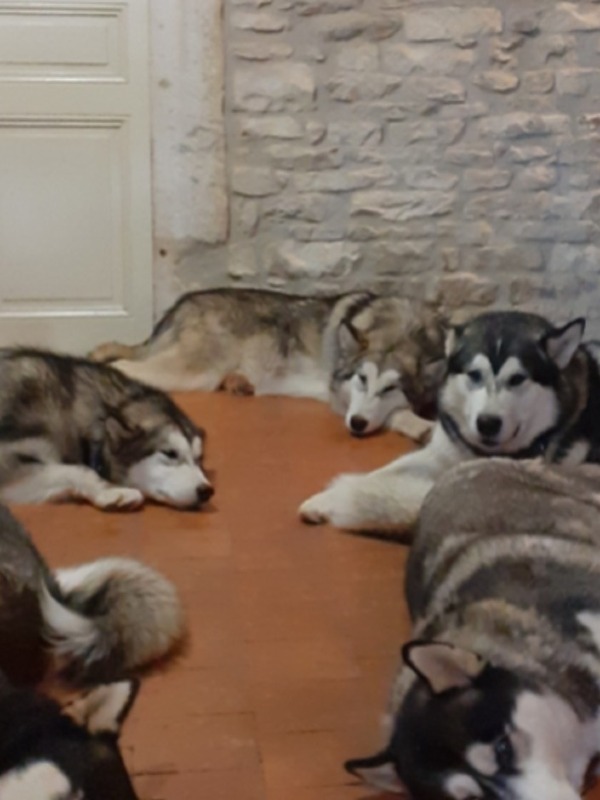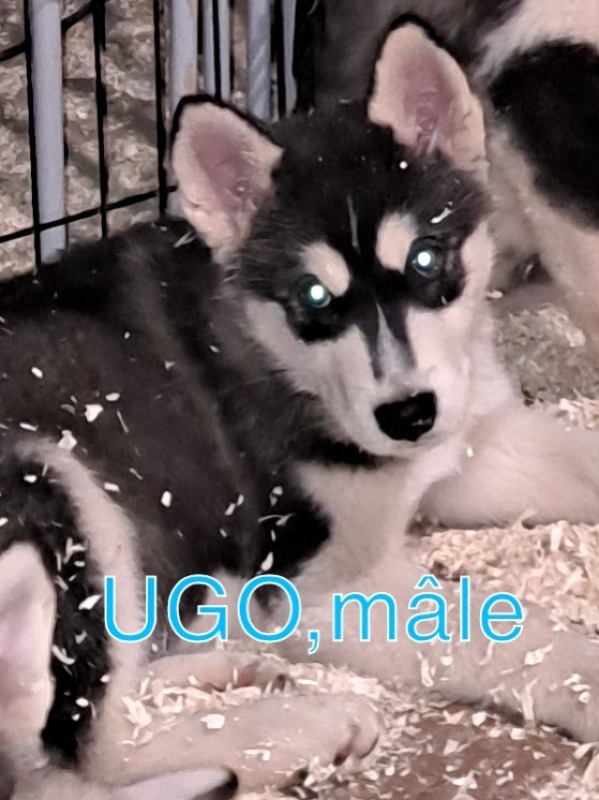Alaskan malamute
Welcome to our page dedicated to the breed of dog alaskan malamute!
Here, you will find all the useful information about alaskan malamute. This descriptive profile will allow you to discover the aspects of this breed. You can notably consult information about the average price, monthly and annual upkeep expenses, their health, name ideas, as well as their official recognition by competent authorities.
Explore this page to discover everything you need to know.
Overall description of the breed
The Alaskan Malamute, as its name suggests, hails from the 49th state of the United States, Alaska. It belongs to the oldest dog breeds, primarily used for hunting and sledding for millennia. Its name is derived from the Mahlemiut tribe, residing in the northwest of the state, specifically in the Kotzebue region.
Appreciated for its physical qualities and resistance to extreme weather conditions, the Malamute was often used in the 19th century to transport valuable goods such as gold and medicines between cities and remote regions.
However, at the beginning of the 20th century, the Malamute faced extinction when the gold rush ended. Due to its reputation, a handful of individuals were brought back to the United States for breeding, giving the breed a new lease on life. During World War II, the U.S. Army even used the Malamute to transport ammunition and soldiers on battlefields.
It was only a few years later that the Malamute made its appearance in Europe, notably in Belgium. However, it did not immediately find success, and it wasn't until the 2000s that its popularity began to rise again. The International Cynological Federation officially recognized it on May 13, 1963, and its current standard was published on August 14, 1996.
The Alaskan Malamute is a medium-sized dog, well-proportioned and solidly built. Possessing innate elegance, it has a dignified and confident gait, with lines that are heavier than those of its close relative, the Siberian Husky. Its mischievous gaze reflects its great intelligence, coupled with impressive endurance and musculature. Its ability to withstand effort is incredible, making it highly appreciated by mushers worldwide. It can cover distances of up to 130 km per day.
Its limbs are powerful, agile, and robust, with a straight backline that is broad, fairly short, and slightly curved at the level of the loins. Its head is round, with a moderately long muzzle that is pointed but not overly so. Its rounded-tipped ears stand erect on the top of its head.
The Alaskan Malamute boasts a medium-long, dense, and compact coat, combined with an abundant undercoat, providing excellent protection against the icy temperatures of the Arctic. The colors allowed by the breed standard are black, gray, white, sand, with some individuals exhibiting a distinctive facial marking characteristic of the breed.
The Alaskan Malamute is deeply affectionate and attached to its owners, yet it retains a certain independence typical of Nordic dogs. It is a pleasant life companion, always ready to share playful or sporting activities with its masters. While it may not be very obedient, its training should begin early, with consistency and determination, yielding good results, though it can be stubborn at times.
It is calm and serene, not a hyperactive dog, but it needs regular and intense exercise every day to thrive fully. Accustomed to wide open spaces and icy temperatures, it is not suited for urban life, although it can easily adapt to various environments.
It is sociable, especially with its peers and unfamiliar people. However, due to its highly developed hunting instinct, increased supervision is required when small animals are present. The Malamute is renowned for its loyalty, courage, and love for its loved ones. When well-trained, it becomes an excellent life partner for all members of the family.
In adulthood, male Malamutes typically weigh around 38 kg (84 lbs) and measure approximately 63 cm (25") at the withers, while females weigh about 34 kg (75 lbs) and measure around 58 cm (23") at the withers.
Awareness of acquiring an animal
Each animal is a sensitive being, deserving love, attention and care.
When you choose to adopt an animal, you take on the responsibility of ensuring its health and well-being throughout its life.
To learn more about animal welfare, we invite you to consult our FAQ by clicking the button below:
Origins
The Alaskan Malamute, one of the oldest sled dog breeds, originates from the Mahlemuts, an Inuit people living in northwest Alaska. These sturdy dogs were used for transporting heavy loads over long distances, as well as for hunting seals and polar bears.
History
Race played a crucial role in the survival of indigenous peoples in the Arctic regions due to its strength and resilience. At the beginning of the 20th century, the Alaskan Malamute gained popularity in the first sled races and polar expeditions, highlighting its remarkable endurance.
Standard
The breed standard highlights a powerful dog, with a well-muscled body and a broad head. The Malamute has a thick double coat to protect it from cold climates, with colors ranging from light gray to black, through to sand and red, always with white markings. Males measure up to 63.5 cm at the withers and weigh about 38 kg, females being slightly smaller.
Physical characteristics
With its impressive and majestic look, the Alaskan Malamute is recognizable by its thick fur, its bushy tail carried on the back, and its dignified and proud expression. Its almond-shaped eyes are dark brown, expressing intelligence and curiosity.
Character
The Alaskan Malamute is known for its friendly, loyal, and affectionate temperament. It is an energetic, courageous, and independent dog, with a strong pack instinct. Although it can be stubborn, it is also intelligent and responsive to training.
Life expectancy
The average lifespan of an Alaskan Malamute is generally 10 to 14 years. With proper care, a balanced diet, and enough exercise, they can enjoy a long and healthy life.
Exercise and activity needs
This breed requires a lot of daily physical exercise to maintain its physical and mental shape. Activities like hiking, jogging, and, of course, sledding, are ideal for expending its boundless energy.
Recommended diet
A high-quality diet, rich in proteins and suited to his activity level, is crucial for the Malamute. It is important to monitor his diet to prevent overweight, especially if his activity level decreases.
Training and obedience
The Malamute is intelligent but independent, which can make training challenging. Early, firm, and consistent training, based on positive reinforcement, is recommended for the best results.
Behavior with children
The Alaskan Malamute is generally good with children, showing patience and affection. However, its large size requires supervision when interacting with very young children to avoid accidents.
Compatibility with Other Animals
Although the Malamute may get along with other dogs and pets, its strong prey drive may lead it to chase small animals. Early socialization is essential to encourage peaceful interactions.
Grooming needs
Its thick double coat requires regular brushing to avoid tangles and reduce shedding, especially during shedding seasons. Occasional baths are sufficient, as its coat repels dirt.
Health
Alaskan Malamutes can be prone to health issues such as hip dysplasia, cataracts, and hypothyroidism. Regular veterinary check-ups are recommended for early detection.
Average price
The price of an Alaskan Malamute puppy can vary significantly, from 800 to 2000 euros, depending on its lineage and the breeder's reputation.
Expenses
The annual costs for maintaining an Alaskan Malamute, including food, veterinary care, and grooming, can amount to about 1000-2000 euros.
Name ideas
Names like Nanook, Yukon, Shadow, Luna, and Bear are popular for Alaskan Malamutes, often reflecting their arctic heritage and imposing nature.
Legislation and regulation
There is no specific legislation concerning the Alaskan Malamute. As with all breeds, proper education and socialization are essential to ensure balanced behavior.
Official recognition
The Alaskan Malamute is recognized by major cynological organizations, including the American Kennel Club (AKC) in the United States, the NHSB (Nederlands Honden Stamboek) in the Netherlands, the SKG (Schweizerische Kynologische Gesellschaft) in Switzerland, the RSCE (Real Sociedad Canina de España) in Spain, and the CKC (Canada Kennel Club) in Canada, all of which are dependent on the Fédération Cynologique Internationale (FCI).
Pedigrees
Pedigrees, certifying the purity of the lineage of the Alaskan Malamute, are available from breed clubs and cynological organizations.
Destination and usage
Traditionally used for sledding, Alaskan Malamutes are today valued as pet dogs for their loyal and affectionate nature, as well as for winter sports and outdoor activities.
Prohibitions
There are no specific bans for the Alaskan Malamute. Special attention must be given to their needs for exercise and socialization to prevent undesirable behaviors.
Breeders ofAlaskan malamute
Want to see more breeders ofAlaskan malamute?
Check out the page of our directory listing all breeders ofAlaskan malamuteClassified Ads ofAlaskan malamute
Breed clubs ofalaskan malamute
No ofalaskan malamute breed clubs are currently registered on Preeders.
If you would like to highlight your breed club, sign up for free now and be the first to appear on this page.





